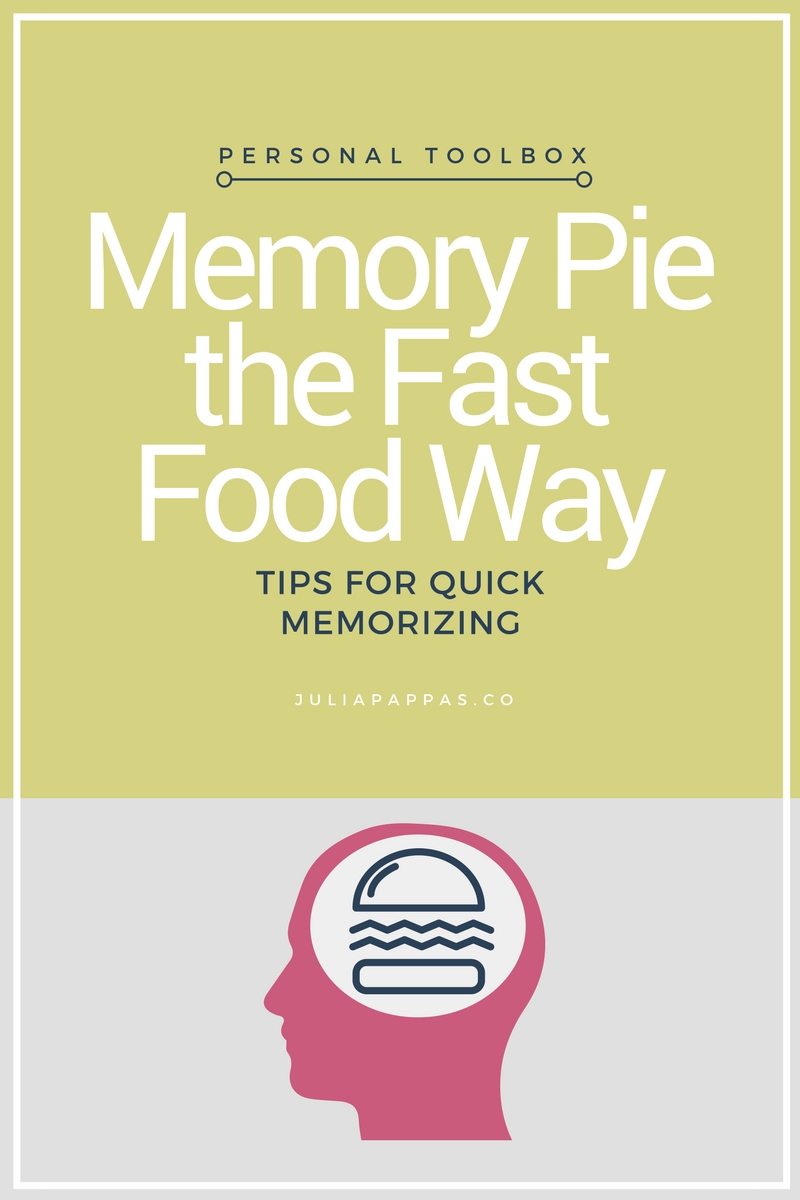You can benefit to the fullest from proper memory tools. Here is a mnemonic device for when you need a quick trick instead. Even though over time you may lose the information you learn this way, it is still the best option to help memorize something in the shortest period of time possible.

We have talked about the proper ingredients that go into the Memory Pie over here and have established why those ingredients are so important for long-term remembering of information and concepts. Understandably, there are times you may need to resort to very quick strategies. Like the fast-food option, they don’t take too long to bring about the result — which is, to memorize something. But before we jump right into my very best strategy for times like these, I do want to warn you that these methods have limitations.
Pros & Cons
The most important limitation is that these types of memory tricks will not lead to long-lasting meaningful remembering, as they would if the information is really explored and learned. However, if you are using this method for something you will only need to remember for a short period of time, then this is precisely the strategy to use.
Another warning is that you should avoid using tricks alone and try to engage your memory through meaningful connections, as was discussed in the Memory Pie Recipe. Just like you wouldn’t only eat fast-food, because you know it is not good for you, you should not be trying to memorize using tricks alone. And now, onto my favorite method.
You have a piece of information you need to remember and it so happens that it is not very meaningful, like a string of numbers or letters. You need to memorize it and you want a quick solution.
Perhaps you tried repeating those numbers and letters out loud or tried to come up with some sort of a rhyme. If you have used these strategies you probably found that they are not very effective, and the reason why is that they still do not make the information meaningful. The most effective way to memorize random information is to create visual images that go with it.
Our brain is primed for visuals and storytelling so all of our efforts to remember any type of information should result in a picture or a storyline that we can also visualize.
The more random is the information, the more creative you need to get with your imagery. The more creative you are in the visual images you create, the more likely you are to remember the story because it is unusual in its composition. The images must be created by you because only you will know what associations and connections your mind makes when thinking of one thing or another.
Any information, including random numbers and letters, can be connected to meaningful concepts and then turned into a visual image, which is then easy to remember.
Yes, mindlessly repeating a bit of information may sound like an easy thing to do, and it is, but you will not remember any of it as soon as you think of something else. On the other hand, the visual method will allow you to spend a few seconds to a couple of minutes (depending on the length of what you are trying to remember), continue doing other things, and then still recall the information days later.
Let’s say you are trying to memorize a license plate, which consists of letters and numbers. In order to apply this visual method, you begin to imagine various objects that either: a) look like the letters and numbers you are seeing, b) begin with the letter on the license plate, c) represent the numbers you are seeing, or d) sound similar or rhyme with letters and numbers on the license plate. These images must be your own associations, because only you will be able to make meaningful connections.
The more colorful and vivid those images are, the better will be your connection to the original information you tried to remember.
Let’s try it out!
For example, the number-letter sequence is M35P8W. These are examples of visual associations that can be made for this random information. M=Me, as I am very likely to remember myself in any scenario. 3 and 5 are combined into 35, which I can pretend is a birthday, and so I can imagine a candle that says 35. Now that I am on a birthday train of thought, I see that I can use P for People at my Party, and I know there are 8 of them, because I can name and visualize specific family members or friends that are in attendance. As to the W, I imagine it being an upside down M, which is Me, only upside down and, given that I am at my own birthday party, I can think of a number of reasons I could visualize myself being upside down. Perhaps I am doing cartwheels, because I feel great, or I am doubled-over with a bucket because I ate too much cake and feel sick. In order to remember best, I would pick what I can most relate to. To end this example, I tell myself that the story starts with me (M) and ends with me (W), only upside down.
I hope you agree, that remembering a story like this one is easier than memorizing M35P8W. I will most definitely remember it for days and weeks to come. One important parting note I would like to make is that when this visual story is created it needs to be decoded back into the original information we started with. If we don’t do that, we may forget what our images stand for. This method works every time for me and the students I work with.
Give it a try and let me know what you think of it!
